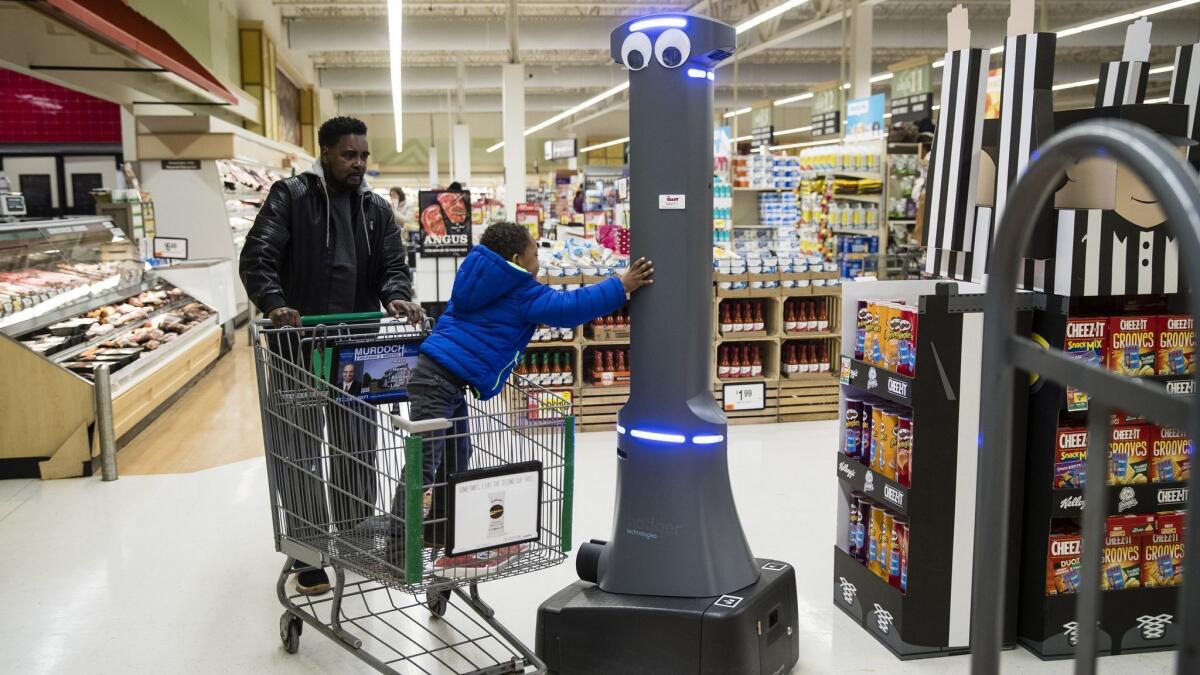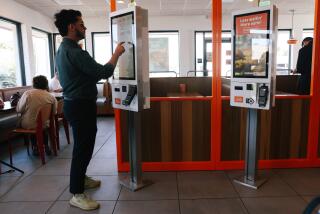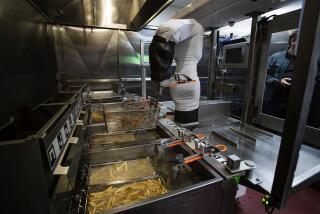Commentary: Retailers are wasting their time on tech that looks exciting but isn’t useful

- Share via
Tens of thousands of retail and tech professionals descended on New York last week for the National Retail Federation’s Big Show, an annual industry confab where exhibitors show off new innovations and the crowd collectively scoffs at the idea of any kind of looming retail apocalypse. The great sport of the event is wandering the rows of booths and trying to separate the fanciful from the legitimately useful.
As always, there were some displays that were eye-catching but left me underwhelmed. I’m thinking, for example, of an Intel Corp. and Asics interactive shoe display that incorporated a touchscreen on a pedestal to enable a shopper to get more information about the features of a certain sneaker.
For the record:
6:25 p.m. Jan. 21, 2019An earlier version of the photo caption with this article said the robot was cleaning the floors. The robot does not clean floors; rather, it monitors the store to see if cleaning or restocking is needed and alerts workers.
It reminded me a bit of a technology experiment I saw out in the shopping wilds on Black Friday at a Macy’s store. A touchscreen showed a video that helps you “discover your fit” among various dress shirts. But the analog sign right next to it explained the shirts and their different fits capably. The screen wasn’t adding enough value to the customer to make it worthwhile.
Macy’s Inc. is hardly alone. Innovation that isn’t actually an improvement is quite common in retail. That is regularly evident at the Big Show and in plenty of other ways, too. Walgreens Boots Alliance Inc., for instance, is touting a test of digital cooler doors that can serve targeted ads. Great, just what every shopper has always wanted: to be bombarded with ads when trying to grab a soda.
The Big Show did bring my attention to some innovation that wasn’t particularly flashy but seemed really valuable. One was an “internet of things” partnership between Microsoft Corp. and Starbucks Corp., through which the coffee chain’s brewing machines are outfitted with a small device that contains one of the tech giant’s Azure Sphere chips. These chips connect the machines to servers so they can automatically receive new recipes.
Consider how new recipes were distributed until now: Twice a year, Starbucks put the formulations on some 8,000 USB drives and then had regional maintenance technicians visit its stores nationwide to plug the drives into the machines. That’s incredibly inefficient.
This isn’t the kind of novelty that’s going to get Starbucks a “60 Minutes” segment (cough, Amazon’s drones). And it’s not going to wow customers like, say, an in-store robot (ahem, Giant Food Stores). But this is exactly the kind of innovation retailers should be prioritizing.
For one, it remedies an obvious problem: It eliminates the need for a technician to zigzag all over to do a rote task, and it gets rid of the risk of having proprietary recipes floating around on easy-to-lose USB drives. Also, it gives Starbucks real-time data about when the brewing machines need to be serviced, so baristas don’t have to take time to make that assessment and call it in. In this way, the project is directly connected to a broader strategic goal at Starbucks, which is to free up store workers to spend more time interacting with customers.
Sadly, many efforts to transform retailing with technology don’t have similarly clear utility. Scott Emmon, a former Neiman Marcus Group executive who recently left his post as head of its innovation lab, published an op-ed this month that captured this dynamic. In his piece for trade publication Business of Fashion, titled “Why I’m Leaving Neiman Marcus,” he wrote:
“Technology must actually solve a real problem or make things easier for the customer. Internal innovation teams, largely pressured to create PR moments, do not think long term and end up investing in short-sighted experiences that have no staying power and don’t really add value to the consumer.”
He’s right: Retailers seem to place too much of a premium on showmanship when charting their innovation course. They must learn to be more strategic in how they deploy their technology budgets and talent. They should go for the projects like the Microsoft-Starbucks one, which has a specific, beneficial outcome, even if it doesn’t get oohs and aahs from consumers. (If it’s working right, consumers won’t even know it is exists.) There are many supply-chain investments, for example, that fit this bill.
As for customer-facing tech innovations, retailers shouldn’t get starry-eyed over the stuff that looks like it’s from “The Jetsons.” They should prioritize the things that make their stores and websites more engaging — and more of a breeze for shoppers.
Halzack is a Bloomberg Opinion columnist covering the consumer and retail industries.
More to Read
Inside the business of entertainment
The Wide Shot brings you news, analysis and insights on everything from streaming wars to production — and what it all means for the future.
You may occasionally receive promotional content from the Los Angeles Times.










